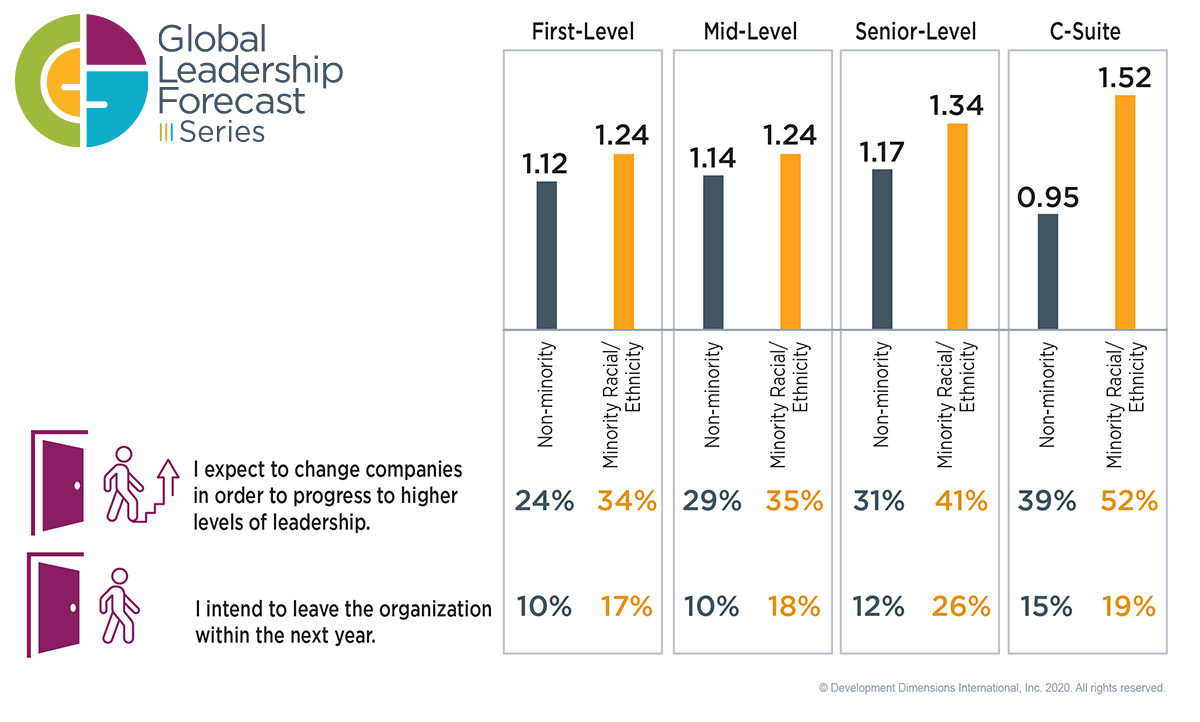For decades, companies have been slowly incorporating diversity and inclusion best practices into their talent strategy. In our Diversity and Inclusion Report 2020, we looked at the data to find out if it’s really working.
And like most reports, there’s good news and bad news. The good news? Leaders from minority racial and ethnic backgrounds are starting to see faster advancement.
But the bad news? Women and minority leaders are heading for the door much faster than their peers. And it gets much worse the higher up you go. In fact, more than one in four senior-level minority leaders say they expect to leave their companies to advance. Compare that to only 12% of their non-minority peers.
Average Number of Promotions in Past Five Years, Minority vs. Non-Minority Leaders

The financial risk is huge. The study also showed that companies that perform in the top 10% financially are significantly more diverse.
What are the biggest missed opportunities for your company? How can you apply diversity and inclusion best practices to improve the retention of diverse leaders?
Based on our research, here are seven D&I best practices to help you drive a more diverse leadership pipeline.
7 Diversity and Inclusion Best Practices
1. Make sure your leaders have high-quality, personalized development plans.
Provide leaders with the tools and plan for how to develop their skills. This puts them in the best position to successfully grow their career at your company.
2. Encourage ongoing performance management discussions with a heavy focus on personal development.
Performance management discussions should be an ongoing cadence for managers. This will help support personalized development. It will also help identify opportunities for growth.
3. Build a core leadership program for all leaders.
Your leaders’ behavior drives your culture. To ensure that you have an inclusive culture, your leaders need a common set of skills and tools. Having a core program also helps make your leadership culture more inclusive. In addition, it reinforces the importance of leaders’ roles in building talent and inclusion.
Companies designated as "Best Places to Work" rate 75% higher for inclusion.
4. Invest in employee health and well-being.
Establish flexible work practices, which is especially important as more companies have a virtual workplace. This sets the tone for an inclusive and supportive workplace culture.
5. Clearly define competencies for leadership success and promotion.
Leaders need to know what it takes to succeed so they can develop their career by defining competencies. However, our data also showed that many women and minorities felt that they didn’t have as much clarity about what it takes to succeed. That makes it harder for them to know if they are on the right track.
6. Incorporate formal programs to ensure smooth leadership transitions at all levels.
Building diversity into your organization’s leadership pool is the only way to fuel a strong and diverse future bench. Most importantly, having programs to ensure smooth transitions throughout the leadership pipeline, from frontline to C-suite, gives all leaders the tools and support they need to succeed.
7. Use data to make fair hiring and promotion decisions.
Using validated assessments and structured simulations provides the data to inform more objective and fair hiring practices.
How to Realize the Benefits of D&I
No matter how many diverse candidates you hire, you need a fair and inclusive culture to make them stay. Otherwise, you’ll end up with a revolving door of diverse talent, without achieving any of the benefits.
Now is the time to take a hard look at your company. How diverse are your leaders? How diverse is your high-potential pool? These leaders will be tomorrow’s executives and C-suite. You need to work on retaining them and developing them now to build excellence for the future.
For more of our latest research, download our special diversity and inclusion report from the Global Leadership Forecast series.
Stephanie Neal is Director of the Center for Analytics and Behavioral Research (CABER). She leads market and trend research focused on executive leadership and business innovation, and is a co-author of DDI's Global Leadership Forecast.
Topics covered in this blog

